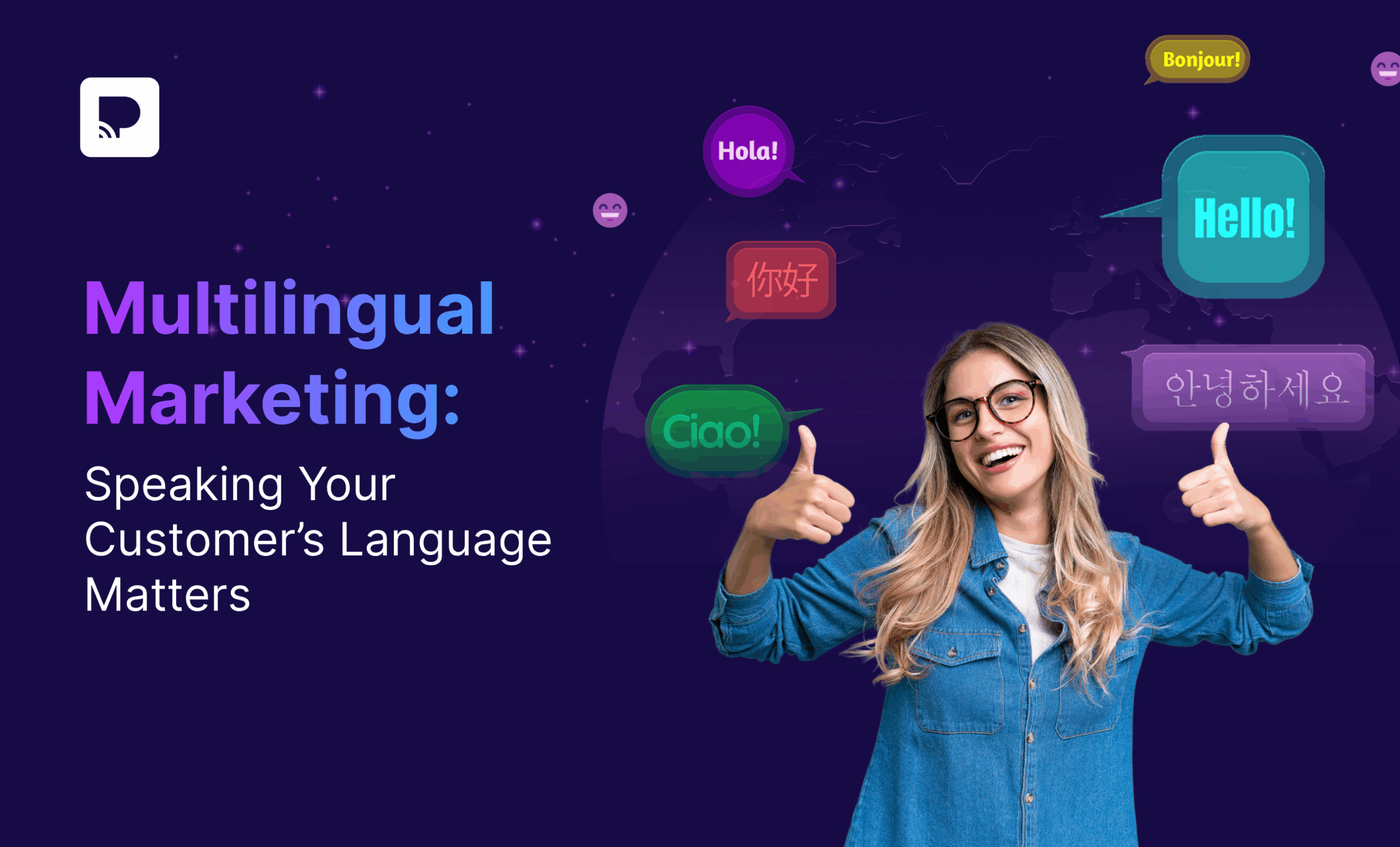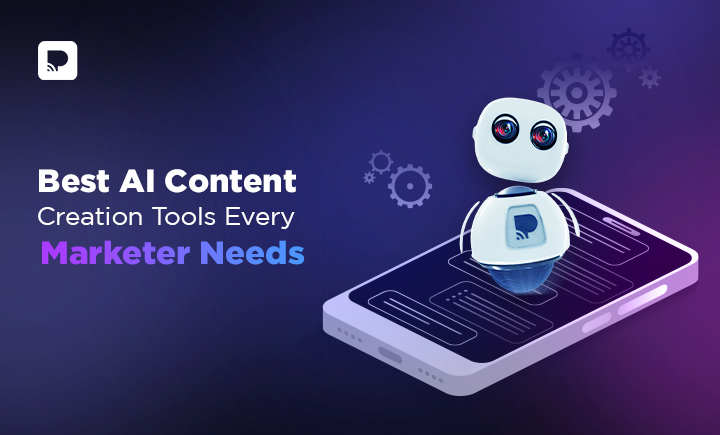| What is Multilingual Marketing, and why should you consider building a multilingual marketing strategy for your business? |
Imagine you ideate and execute the perfect marketing campaign and even achieve the desired results from it. But despite it being a hit, there is still a segment of your audience that doesn’t engage with your campaign. The reason? A monolingual approach. And it doesn’t necessarily mean they don’t understand English; it could also mean that they engage and interact more with content in their own language.
This is why you need to take multilingual marketing seriously. Especially, if your business is based in a vicinity where English isn’t exactly the ‘preferred language’. This means that even though the population may understand English, they may prefer their native language.
| For instance, as of 2021, about 43.9 percent of California’s population was speaking a language other than English at home. |
Besides, the top most spoken languages in the US include Spanish, Chinese, French, Tagalog, Vietnamese, Arabic, Korean, Russian, and German. So, sidelining a multilingual marketing strategy may not be your best bet. Moreover, this is only the local aspect of it. Let’s not forget that multilingual content marketing plays a key role in global expansion.
Now, let’s understand what multilingual marketing really is, why you should invest in it, and most of all, how you can effectively execute a multilingual marketing strategy using automation.
Elevate Your Strategy with Our AI Marketing Tool – Activate Your Free Trial!
Try NowWhat Is Multilingual Marketing?
As the name suggests, it’s marketing in multiple languages. But there’s more to it – you can’t simply translate your marketing material, you have to adapt it. This is to say that different languages have a different essence to them. So, when you work on multilingual content marketing, you have to keep in mind the nuances of the language and even the culture of its speakers.
Why Should Businesses Take Multilingual Marketing Seriously?
Imagine you’re in an unfamiliar setting amongst people you’re meeting for the first time. You notice different groups and one of them is conversing in your native language. Which one are you more likely to approach? Probably the one where everyone is speaking your language, possibly because you’ll feel more comfortable and confident with them, connect with them, and the conversation will flow more smoothly. Well, that is how multilingual marketing works. It makes your target audience feel confident about you, connect with you better, and possibly even engage with you, all leading to better conversions.
Besides, here are a few more reasons for you to adopt a multilingual marketing strategy ASAP:
▪ Surpass Your Monolingual Competitors: Chances are, many of your competitors are only focussing on the English-speaking audiences. So, if you adopt a multilingual marketing strategy, you can easily tap into the underserved markets without facing too much competition and win over more customers.
▪ Form Better Connections: Have you ever heard a group of individuals conversing in their native language? How they connect is beyond comparison. Similarly, when you communicate with your customers in their native language, they connect with you better, and are more likely to explore more about your business.
▪ Inspire Trust and Loyalty: Following up on the previous point, multilingual content marketing can help you inspire trust and loyalty amongst your audience. This is mainly because they feel valued owing to their elevated customer experience.
▪ Convert Better: Naturally, when your audience feels more connected to you, they are more likely to trust what you have to offer. This can lead to increased conversions. And that’s not it, a multilingual marketing strategy can also translate to better retention rate and repeat business.
Now that you know what multilingual marketing is, and why you need to adopt it, let’s get to the question – how to execute a multilingual marketing strategy effectively? Let’s take the example of social media marketing in particular for now.
Steps To Execute Multilingual Marketing Strategy (Social Media Edition)
Step 1: Identify Target Languages and Audiences
Research your audience demographics to determine the primary languages spoken and the key regions to target.
Step 2: Translate and Localize Content
Translate your social media posts and ads, ensuring cultural relevance and appropriateness for each target market.
Step 3: Create Separate Accounts or Pages
Consider setting up dedicated social media accounts or pages for different languages to better manage and engage with each audience.
Step 4: Schedule and Post Manually
Use each social media platform’s native tools to schedule and post content in the appropriate language at optimal times for each target region.
Step 5: Track Engagement and Adapt
- Monitor likes, shares, comments, and other engagement metrics manually for each language-specific post, and adjust your content strategy based on this feedback.
Well, executing a multilingual marketing strategy is easier said than done. It requires time, an allocated budget, and resources, amongst other things. And there is more than one way to go about it. Do you hire experts that actually know the language? For each language that you want to cover? Or do you trust translation tools and let one of your content writers do the work? And if so, how do you ensure accuracy? It can be a lot of work, especially if you take on the manual approach. However, if you bring in automation, it can be an easy task.
Advantages Of Automated Tools In Multilingual Marketing
Just like every other aspect of marketing, you can also leverage the power of automation to add multilingualism to the mix. And it can do wonders for your strategy. For your better understanding, let’s weigh the advantages of using automation for =multilingual content marketing over doing it manually.
| Criteria | Executing Manually | Using Automation |
| Time | Very time-consuming; requires significant effort for each language and content update. | Significantly faster; content can be translated and updated in real-time or with minimal delay. |
| Cost | High costs due to the need for human translators, editors, and project managers. | Lower costs after initial setup; reduced need for human resources, leveraging AI. |
| Resources | Requires a large team of translators, editors, leading to complex coordination. | Minimal human resources needed; relies on AI and machine learning tools for translation and management. |
| Scalability | Limited Scalability; each additional language adds considerable workload and cost. | Highly scalable; new languages can be added with minimal incremental cost and effort. |
| Consistency | Inconsistencies likely due to human error and variations in translation quality. | High consistency; AI ensures uniform translation standards and quality control. |
| Speed of Updates | Slow; every update requires manual translation and review, delaying the process. | Rapid; automated systems can update translations instantly across all languages. |
| Flexibility | Less Flexible; making changes across multiple languages is cumbersome and slow. | Highly flexible; changes can be made quickly and across all languages. |
| Quality Control | Requires extensive review processes to ensure quality and accuracy, which is labor-intensive. | Automated quality control through algorithms and machine learning, reducing the need for extensive manual checks. |
| Adaptability | Adapting to new markets is slow and expensive due to the need for new translators and resources. | Quick adaptation to new markets with minimal additional setup and cost. |
| Integration | Difficult to integrate with existing digital platforms and requires manual updates for each platform. | Seamless integration with various digital platforms and automatic updates across all channels. |
| Error Handling | High potential for errors and miscommunications, with a slower correction process. | Low potential for errors due to advanced AI and quick correction mechanisms. |
Unlock Powerful Insights – Book a Demo of Our AI Marketing Tool and Elevate Your Strategy!
Schedule NowHow To Implement Multilingual Marketing Automation?
Research Your Audience
Understand the demographics, language preferences, and cultural nuances of your target audience.
Finalize Your Languages
Determine the primary languages needed for your marketing campaigns based on your audience research.
Select the Right Marketing Automation Tool
This is the most crucial step of all. Pick a marketing automation tool that supports multilingual capabilities.
Create and Localize Content
Create content in your primary language and use a Translation Management System (TMS) to accurately translate and localize the content for each language.
Automate and Monitor Campaigns
Design and implement automated workflows for each language segment, then use analytics to monitor and optimize campaign performance.
Now Comes The Tricky Part – Choosing The Right Tool
As previously emphasized, choosing the right automation tool that helps you execute your multilingual marketing flawlessly. Because let’s be honest, no one wants to read gibberish even in their own language. So, ensuring the automation platform you choose is tested and tried for accurate translation across languages is crucial. Additionally, consider the following factors.
| Factor | Description | Priority |
| Multilingual Support | Ability to handle multiple languages for campaigns and content. | High |
| User-Friendly Interface | Ease of use for setting up and managing campaigns in multiple languages. | High |
| Analytics and Reporting | Detailed analytics and reporting capabilities for different languages. | High |
| Customer Support | Availability and quality of support for multilingual issues. | High |
| Scalability | Ability to scale as your multilingual marketing needs grow. | High |
| Cost | Pricing structure relative to your budget and expected ROI. | Average |
| Customizability | Flexibility to customize workflows and content for different languages. | Average |
| Training Resources | Availability of training and resources for multilingual features. | Average |
| Integration with Other Tools | Compatibility with CRM, social media, and other marketing tools. | Average |
How About An AI-Powered Assistant With Multilingual Capabilities?
That is Practina AI for you, an AI-powered marketing assistant with the multilingual capabilities you need to converse, connect, and convert better. Not only does it check all the boxes of an ideal multilingual marketing automation tool, it also offers a lot more, and in a lot less.
With Practina, you can not only translate but generate social media posts and ads in multiple languages TAILORED to diverse audiences and platforms including Instagram, Facebook, and Google. That’s not all, it also allows you to personalize your dashboard in your preferred language, making it easier for your diverse team to use it to their advantage.
How It Works:
Select a preferred language, generate social media posts and ads in the language of your choosing, run effective campaigns across platforms, and promote your brand across diverse linguistic landscapes.
How Practina Helped Its Client Achieve Remarkable Growth
Background: Dr. Ana Martinez, the owner of “Smile Bright Dental Clinic,” located in a predominantly Spanish-speaking neighborhood, was facing challenges in attracting a broader patient base. Despite her clinic’s reputation for providing excellent dental care, Dr. Martinez noticed a lack of traction in her marketing efforts. Her promotional materials and online presence, primarily in English, did not resonate with the local community, leading to a decline in patient visits and stagnant growth.
Solution: Dr. Martinez decided to utilize Practina’s multilingual marketing capabilities to better reach her target audience. Practina’s platform offered an intuitive solution that allowed Dr. Martinez to create and manage marketing campaigns in multiple languages, including Spanish. The platform provided tools to translate and localize content, ensuring her marketing messages were culturally relevant and engaging to the local community.
Results: After implementing Practina’s multilingual marketing strategies, Dr. Martinez saw significant improvements in her dental practice’s performance:
- Engagement: Spanish content received 75% more engagement.
- Revenue: Clinic revenue increased by 50% in six months.
- Patient Base: Attracted more Spanish-speaking and bilingual patients.
- Loyalty: Repeat appointments increased by 35%.
End Note: Dr. Martinez’s experience with Practina highlights the critical role of multilingual marketing for small businesses, particularly in diverse communities. By overcoming language barriers and culturally connecting with potential patients, businesses can significantly enhance their visibility and growth. Practina’s user-friendly platform enabled Dr. Martinez to seamlessly integrate multilingual marketing into her practice, resulting in remarkable success.
Reflecting on her experience, Dr. Martinez stated,
“Practina changed the game for us. Being able to communicate with our community in their language made all the difference. Our growth in revenue and patient loyalty is a testament to the power of multilingual marketing.”
Conclusion
A monolingual approach can only get your marketing message so far. And that is why you need to adopt a multilingual content marketing strategy to expand your reach and engage diverse audiences effectively. It is the route you must take to build stronger connections, inspire trust, and increase conversions across linguistically diverse audiences. And to do so effectively, you can consider automation tools like Practina.
FAQs
Q: Why Is Multilingual Marketing?
A: Simply put, generating and disseminating content in multiple languages to reach and engage audiences with diverse linguistic backgrounds is referred to as multilingual marketing.
Q: Why Should Businesses Consider Multilingual Content Marketing?
A: Multilingual marketing offers many advantages that businesses should consider, including:
- A Competitive Advantage
- Extended Market Reach
- Strenger Connections
- Increased Conversion Rate
- Improved Customer Experience
Q: Does Practina Offer Multilingual Marketing Support?
A: Yes, Practina provides robust multilingual marketing support, enabling businesses to create and manage marketing campaigns in multiple languages seamlessly.
Q: Does Multilingual Content Marketing Require Separate Strategies For Each Language
A: Absolutely, tailoring strategies for each language to ensure cultural relevance and linguistic accuracy is a crucial part of executing a successful multilingual content marketing strategy.





